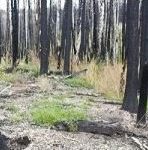“Ghost Forests” Are, Surprisingly, a Sign of Resilience
Posted: January 19, 2017Source: Hakai Magazine B

IMAGE BY PETER MAUTSCH AND MARANSO /DREAMSTIME.COM
Matthew Kirwan’s great-great-grandparents built their home on a piece of property along the Blackwater River in Robbins, Maryland. From the time he was a child, Kirwan explored and hunted there in a small forest grove near the water. But 15 years ago, he started noticing the sea encroaching on the property. In the years since much of the land has been flooded, and the forest—once lush and green—is now full of snags waiting to fall. Everywhere, there are roots and stumps, reminders of where trees once stood. The living ones loom over the water, teetering on the edge of death.
Watching his family’s land drown at such an alarming rate inspired Kirwan, now a professor at the Virginia Institute of Marine Science, to study these so-called “ghost forests”—dead coastal forests that are transforming into marshland. Kirwan and students have discovered that sea level rise has killed more than 400 square kilometers of coastal forest around the Chesapeake Bay since the 1850s. At Goodwin Islands in Virginia, for instance, the rates of forest loss have increased every decade since the 1940s, growing even faster in the past decade. In the United States, ghost forests are most common along the Atlantic coast, from Canada to North Carolina, as well as in Louisiana.
Yet as ominous as these eerie ecosystems appear, Kirwan’s research has shown that they are not a sign of impending doom. Instead, ghost forests actually offer evidence that the natural world is responding to climate change, and resiliently transforming to survive sea level rise. By sacrificing a strand of trees along the coast, the newly-formed marshland can protect the forest and other lands further inland.
Salt marshes are one of the most productive ecosystems on the planet, and they are effective buffers, protecting inland regions from storm surges. “This creation of ghost forests is a sign that marshes are being preserved,” Kirwan says. “They are migrating.”
It’s unclear when ghost forests were first scientifically described, but research started ramping up in the 1980s. And yet, scientists are only just now beginning to understand the complex effects they have on the environment. According to the Virginia Institute research, for instance, carbon sequestration rates may be higher in ghost forests than in the original forest, because the wet soil and healthy marsh ecology replace the dry forest floor.
However, other research has shown that among the most likely plant species to colonize marshlands are the phragmites, a group of perennial grasses. Phragmites sequester less carbon than trees, meaning coastal deforestation could instead lead to more carbon dioxide in the atmosphere.
There are many questions begging for answers: how are plants and animals affected by ghost forests, what are the impacts of coastal deforestation, and how long these types of marshlands will be able to protect inland areas from flooding?
Jennifer Walker, a doctoral candidate at Rutgers University who studies ghost forests along the coast of southern New Jersey, says it is unclear if these marshes will be able to create enough sediment to keep up with further sea level rise. New marshland should be able to buffer against some sea level rise, but may not be able to keep this up for long.
For Walker, ghost forests are a great demonstration of nature’s adaptation to sea level rise. “It’s showing very clearly that if you remove humans from the picture, the coast is preparing itself.”
Kirwan still goes hunting every year on his family’s property, and each time he looks out from his deer stand, he notices the forest has a few fewer trees, and he can see just a little farther. As strange a phenomenon as it is, he often jokes that when it comes to ghost forests, “if you see dead trees, you’re a pessimist.”
“And if you see marsh, you’re an optimist.”

